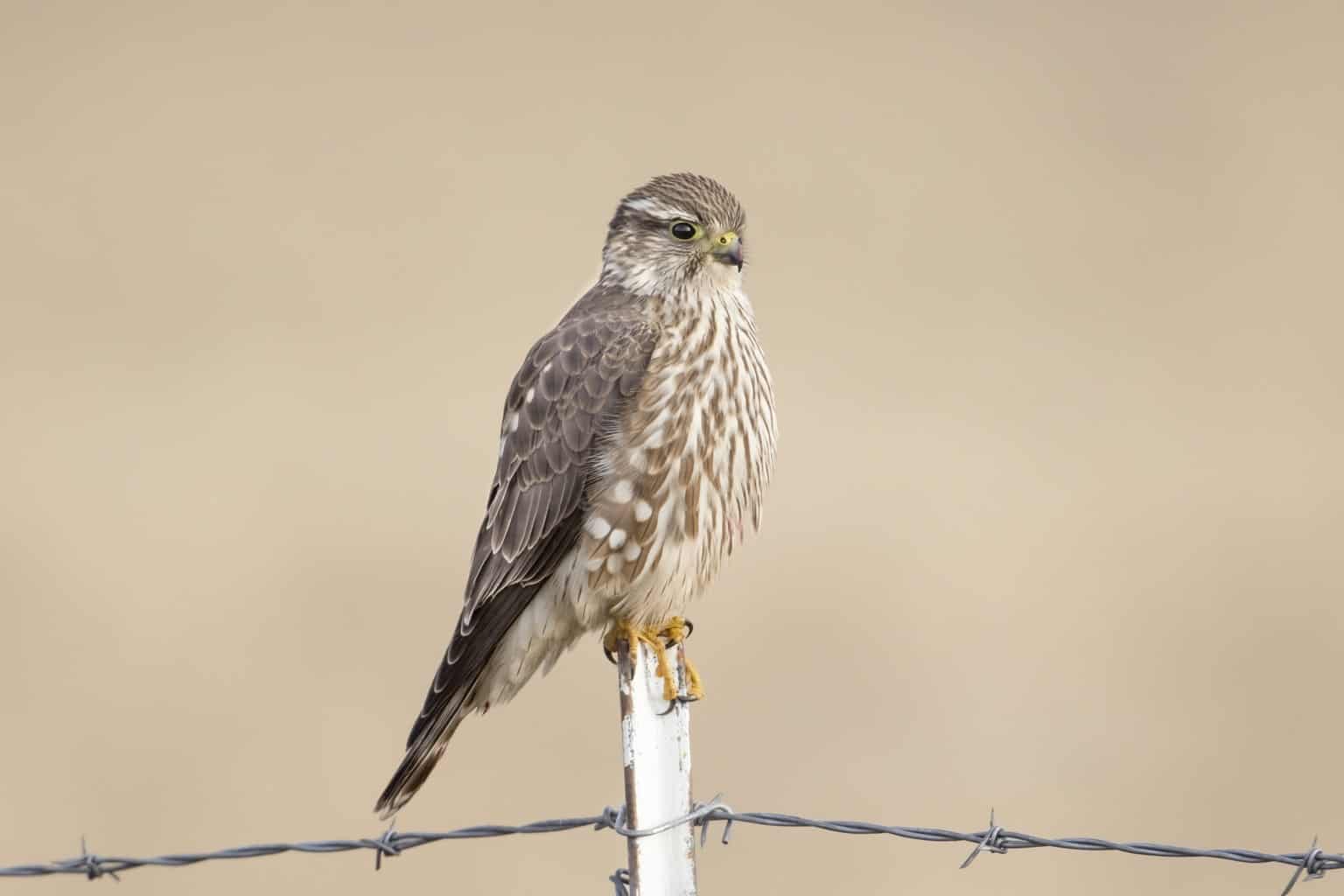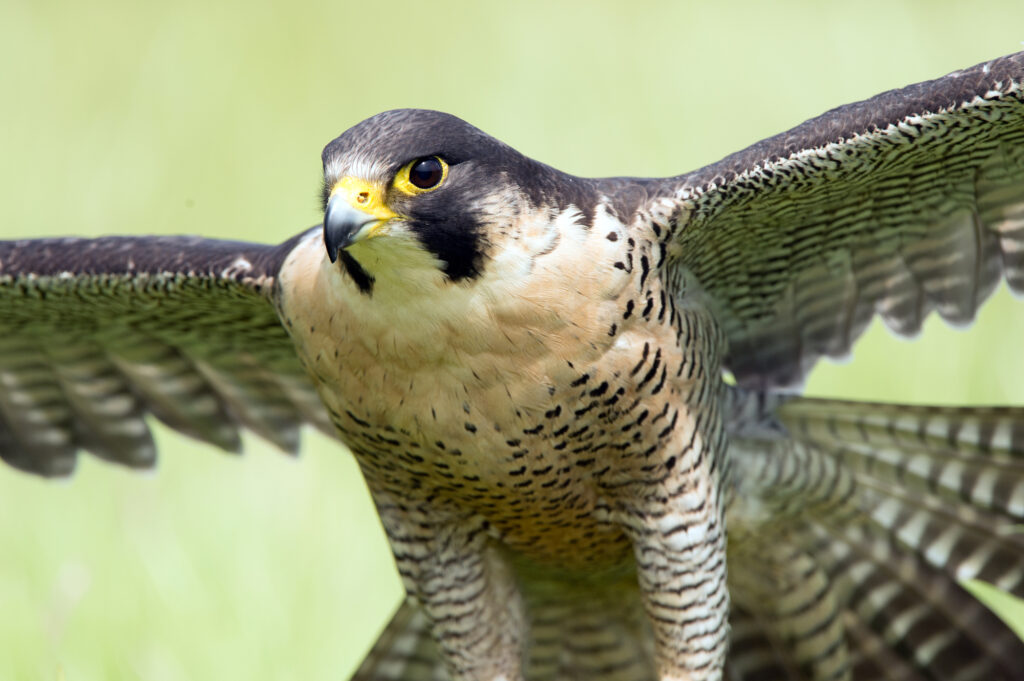The state of Illinois is well-known for its farmlands, which just so happen to be a favorite spot of many falcon species! There are 5 common and not-so-common species you can spot if you get the itch for a little birding.
A big reason why many species of falcons prefer farmlands – or any wide, open space – is so they can better spot prey. However, they’re remarkably adaptable and are also comfortable in forested and urban environments.
Successfully spotting these incredible birds is a mixture of study and luck. I’ll increase your chances with my helpful guide below – you’ll learn about their appearance, hunting habits, and a few fun facts!
American Kestrel

- Species Name: Falco Sparverius
- Weight: 80 grams to 165 grams
- Length: 22 cm to 31 cm
- Wingspan: 51 to 61 cm
The spectacular American Kestrel is a favorite of mine for many reasons. One of the biggest is its striking plumage, a blend of warm and cool colors straight out of a painting.
Appearance
The male American Kestrel is dashing with his blue-gray head and blue wings. The rest of his body is a cinnamon brown with heavy barring along the wings and tail.
If you look closely (or have a pair of binoculars on you), you’ll spot the patches of white, black, and gray on their face. Another distinctive feature of these fierce birds are the dark slashes beneath their eyes – they remind me a little of the markings on a cheetah.
Females look similar to males but are significantly larger (which is a trait all falcon species share). She also has a little less gray and a little extra barring on her tail.
Range
These common falcons show up throughout Illinois all year long, but they’re a little more common during winter. Illinois winters are famously wet, so be sure to bundle up if you want to do outdoor birding.
American Kestrels enjoy a variety of habitats (as long as they’re spacious!). Expect to see them drifting around agricultural fields, deserts, prairies, meadows, and pastures.
A memorable sight you’ll see often is the lone American Kestrel perched on fence posts or a long branch. A prime location to spot American Kestrels – and possibly other falcons – is Prairie Ridge State Natural Area.
If you’re thinking of attracting American Kestrels close to your home, consider building nest boxes. Also known as human-made nest boxes, these falcons will be eager to stick around for some casual observation.
Just make sure your nest box is in a wide, open area! Dense vegetation makes it hard for them to spot predators and prey.
Diet
Why are American Kestrels so comfortable everywhere they go? Their diverse diet plays a part in these widespread raptors’ adaptability – they’ll eat a variety of insects, small mammals, small birds, and the occasional reptile.
Since they’re such small birds, they can easily live on an insect diet. These colorful falcons are particularly fond of moths, dragonflies, and beetles.
Their favorite food items, by far, are butterflies. They’re fast enough to pluck them out of the air mid-flight!
Birdsong
Have you ever noticed how some birds almost sound like an alarm going off? The American Kestrel has a distinctively alarming call of sharp chee-chee-chees or kee-kee-kees.
Fun Fact
Not all falcons drop out of the sky like a stone to catch prey. The American Kestrel is unique in preferring to ‘hover hunt’ – they’ll hover in mid-air and scan the ground before snatching prey.
Peregrine Falcon

- Species Name: Falco peregrinus
- Weight: 330 grams to 1,500 grams
- Length: 34 cm to 58 cm
- Wingspan: 29 cm to 47 cm
What makes the peregrine falcon such a recognizable bird species? Their incredible speed, clocking in at over 200 miles per hour when diving for prey, may have something to do with it!
Appearance
The peregrine falcon is a dashing bird wrapped in gray-black or blue-black plumage. Their bright white stomach has heavy barring, contrasting heavily with their yellow legs and beak.
Female peregrine falcons are notably larger and bulkier than males but have similar plumage.
Range
This iconic falcon is easy to spot throughout the state, though they’re most common during migration. However, since Illinois is generally warmer than environments further up north, most stick around all year long.
Peregrine falcons enjoy a wide variety of environments such as mountain ranges, valleys, and coastlines. However, they’re able to be comfortable in Arctic environments and, increasingly, urban locations.
Diet
The peregrine falcon is an avid hunter of plenty of birds, frequently targeting gamefowl, waterfowl, and songbirds. They often hunt doves, pigeons, and ducks, specifically.
When their usual food supply runs low, they’ll target owls, herons, and even other falcons. They also occasionally hunt foxes, mice, and rats.
Birdsong
Peregrine falcons aren’t known for being particularly talkative falcons, but they sometimes let out shrill, swooping calls. They also let out rough kek-kek-kek patterns.
Fun Fact
While peregrine falcons have a long history of being trained as hunting birds, they can actually take on safety jobs, too! Peregrine falcons are sometimes trained to scare off stray ducks or birds that could potentially collide with airplanes.
Merlin

- Species Name: Falco columbarius
- Weight: 125 grams to 300 grams
- Length: 24 cm to 33 cm
- Wingspan: 58 cm to 66 cm
This sleek and beautiful falcon is a little tricky to spot due to their varied plumage and tendency to wander. However, you’ll be able to recognize them if you pay close attention to their face.
Appearance
The merlin is a gorgeous falcon with large eyes, a small beak, and a sharply pointed tail. While they have different morphs – or plumage – the ones below are the most common:
- Pacific Northwest Merlin – a dark blue (almost black) with a bright white stomach
- Black Merlin – a dark gray-blue with a bright white stomach covered in streaks
- Coastal Forest Merlin – also a dark gray-blue with a white stomach covered in streaks
- Prairie Merlin – a soft, dusty brown with a heavily flecked stomach
You’re most likely to see the prairie merlin, though you may glimpse the others. Females tend to be a little larger and lighter in color than males.
Range
Merlins, similar to peregrine falcons, enjoy a wide variety of environments. You can easily spot them in prairies, grasslands, coastal areas, and dense forests.
Since they’re not the most habitat-specific, you’re most likely to spot them by hanging outdoors and keeping an eye out for open spaces where they’ll be hunting. These birds of prey usually show up throughout Illinois, but become more scarce once winter hits.
Here’s a tip: check out Illinois Beach State Park to see some merlins up close!
Diet
These fierce falcons usually hunt small bird species, but they’ll quickly switch to other food sources depending on the most common animals in their environment. They’re also known to hunt reptiles, small mammals, bats, frogs, and even insects.
Birdsong
Sometimes the best way to spot a bird is to compare their call to something familiar. I always thought the merlin sounded like they were laughing with their trilling heh-heh-heh call.
Fun Fact
Falcons aren’t big fans of building their own nests – the merlin tends to inhabit the abandoned nests of crows.
Prairie Falcon

- Species Name: Falco mexicanus
- Weight: 500 grams to 970 grams
- Length: 38 cm to 45 cm
- Wingspan: 102 to 107 cm
These falcons are a little rarer in Illinois, but you’ll still spot a few here and there in the southern portion of the state.
Appearance
The prairie falcon has soft and earthy coloration, boasting gray-brown feathers and a ‘mustache’ pattern around their beak. They have a heavily flecked stomach and fluffy legs – they almost look like they’re wearing pants.
Females are almost twice as heavy as males and look even bulkier.
Range
Expect to see these falcons most commonly during migration and winter in Illinois, though their numbers aren’t quite as large as peregrine falcons.
As per their name, prairie falcons’ preferred habitats are flat, open spaces – think grasslands, agricultural fields, deserts, prairies, and deserts.
Diet
Prairie falcons will switch between various small mammals and small to medium bird species for their primary food source. In fact, they’re such effective hunters, their feeding patterns tend to match the season they’re in.
They generally hunt songbirds during spring when they’re most active but switch to mammals during the summer.
Birdsong
These falcons also sound like they’re laughing – expect to hear very familiar-sounding haw-haw-haaaw patterns.
Fun Fact
Despite this bird’s subdued plumage, they undergo an interesting visual transformation upon adulthood. Immature birds start off with blue-gray legs that become yellow once they hit a year old.
Gyrfalcon

- Species Name: Falco rusticolus
- Weight: 1,350 to 2,100 grams
- Length: 48 to 65 cm
- Wingspan: 110 to 160 cm
This accidental species is worth keeping an eye out for. The gyrfalcon is the largest falcon species and is so lovely, it looks straight out of a dream.
Appearance
The gyrfalcon also comes in a variety of morphs, all with their own beautiful markings. While you’ll easily recognize them for their massive size and fluffy feathers, below are a few of the most common colorations:
- Black – a brown-black body with a speckled stomach and spotted head
- Brown – a cream body and spotted stomach with dark brown wings
- White – a bright white body sprinkled with dark spots along the back and wings
- Silver/gray – a silvery body with a light stomach and dark gray wings
White and silver/gray are easily the most common in North America.
Range
The gyrfalcon is rarer in Illinois because they generally prefer to inhabit distant islands, ocean coastlines, and tundra. Since all three don’t exist in the state, gyrfalcons usually only appear during winter when they’re drifting outside of their usual range.
If you’re lucky, you may also spot a few of the wintering hawk species in Illinois!
Diet
These powerful birds hunt a variety of birds and mammals, many of which are usually too big for other falcons. While they often go after geese and gulls, they’ll also target hares, Arctic foxes, and occasionally trout.
Birdsong
Gyrfalcons are majestic falcons who boast a call that’s subdued and rather intense, often letting out strained hwaaauh-hwaaauh patterns. It’s the kind of sound that makes the wilderness feel just a little more mysterious.
Fun Fact
These magnificent birds are so large and in charge, they have no natural predators. While the gyrfalcon can be eaten if they become sick or injured, they’re not a regularly targeted species for any animal.
Illinois Is a Treasure Trove of Beautiful Falcon Encounters
With a few rare species as well as year-round standbys, Illinois is a treasure trove for the active birder. This state’s gorgeous plains look even better with a falcon spreading its wings!
Peregrine falcons, prairie falcons, and American Kestrels are rather easy to spot in the state. If you’re going to be in Illinois during the winter, I recommend keeping an eye out for the gyrfalcon – they’re truly a sight to behold.
For birders who like to travel and need a starting point for falcon-watching, check out Prairie Ridge State Natural Area and Illinois Beach State Park.
What else does Illinois have for your next birdwatching trip alongside an appreciation of falcons? Our guide on birds in Illinois will help you spot swallows, finches, pelicans, and much more.

